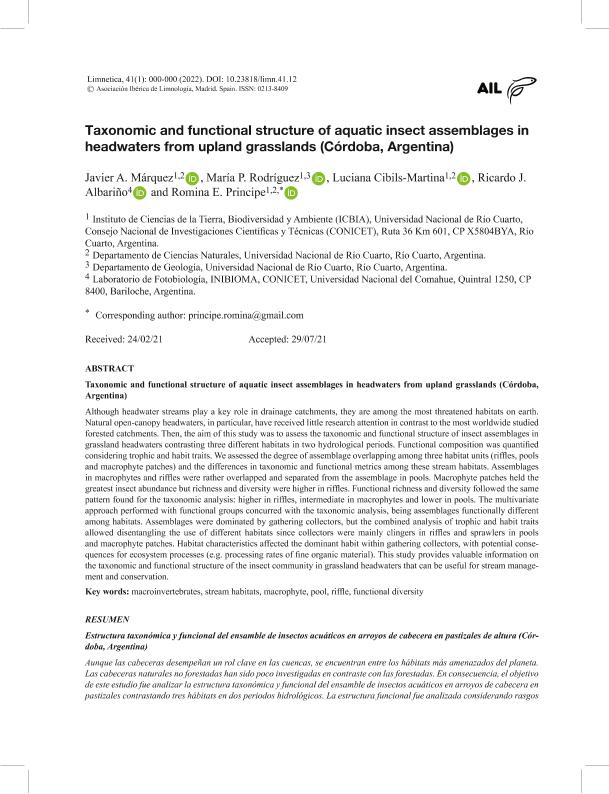Artículo
Aunque las cabeceras desempeñan un rol clave en las cuencas, se encuentran entre los hábitats más amenazados del planeta. Las cabeceras naturales no forestadas han sido poco investigadas en contraste con las forestadas. En consecuencia, el objetivo de este estudio fue analizar la estructura taxonómica y funcional del ensamble de insectos acuáticos en arroyos de cabecera en pastizales contrastando tres hábitats en dos periodos hidrológicos. La estructura funcional fue analizada considerando rasgos alimentarios y hábitos. Evaluamos el grado de solapamiento entre rabiones, pozas y parches de macrófitas; y las diferencias en métricas taxonómicas y funcionales entre estos hábitats fluviales. Los ensambles en macrófitas y en rabiones se solaparon parcialmente y se separaron del ensamble de las pozas. Los parches de macrófitas alojaron la mayor abundancia, pero la riqueza y la diversidad fueron mayores en los rabiones. La diversidad y la riqueza funcional presentaron el mismo patrón que el análisis taxonómico: fueron mayores en los rabiones, intermedias en las macrófitas y menores en las pozas. El análisis multivariado de grupos funcionales coincidió con el análisis taxonómico siendo los ensambles funcionalmente diferentes entre los hábitats. Los recolectores fueron predominantes, pero el análisis combinado de los rasgos alimentarios y los hábitos permitió distinguir el uso de los diferentes hábitats ya que los recolectores fueron principalmente agarradores en rabiones y reptadores en pozas y macrófitas. Las características del hábitat afectaron en consecuencia el hábito dominante dentro de los recolectores, con consecuencias potenciales sobre los procesos del ecosistema (e. g. tasas de procesamiento de la materia orgánica fina). Este estudio provee valiosa información sobre la estructura taxonómica y funcional de la comunidad de insectos acuáticos en cabeceras en pastizales que puede ser útil para el manejo y la conservación del recurso. Although headwater streams play a key role in drainage catchments, they are among the most threatened habitats on earth. Natural open-canopy headwaters, in particular, have received little research attention in contrast to the most worldwide studied forested catchments. Then, the aim of this study was to assess the taxonomic and functional structure of insect assemblages in grassland headwaters contrasting three different habitats in two hydrological periods. Functional composition was quantified considering trophic and habit traits. We assessed the degree of assemblage overlapping among three habitat units (riffles, pools and macrophyte patches) and the differences in taxonomic and functional metrics among these stream habitats. Assemblages in macrophytes and riffles were rather overlapped and separated from the assemblage in pools. Macrophyte patches held the greatest insect abundance but richness and diversity were higher in riffles. Functional richness and diversity followed the same pattern found for the taxonomic analysis: higher in riffles, intermediate in macrophytes and lower in pools. The multivariate approach performed with functional groups concurred with the taxonomic analysis, being assemblages functionally different among habitats. Assemblages were dominated by gathering collectors, but the combined analysis of trophic and habit traits allowed disentangling the use of different habitats since collectors were mainly clingers in riffles and sprawlers in pools and macrophyte patches. Habitat characteristics affected the dominant habit within gathering collectors, with potential consequences for ecosystem processes (e.g. processing rates of fine organic material). This study provides valuable information on the taxonomic and functional structure of the insect community in grassland headwaters that can be useful for stream manage-ment and conservation.
Taxonomic and functional structure of aquatic insect assemblages in headwaters from upland grasslands (Córdoba, Argentina)
Título:
Estructura taxonómica y funcional del ensamble de insectos acuáticos en arroyos de cabecera en pastizales de altura (Córdoba, Argentina)
Márquez, Javier Andrés ; Rodríguez, María Pía; Cibils Martina, Luciana
; Rodríguez, María Pía; Cibils Martina, Luciana ; Albariño, Ricardo Javier
; Albariño, Ricardo Javier ; Principe, Romina Elizabeth
; Principe, Romina Elizabeth
 ; Rodríguez, María Pía; Cibils Martina, Luciana
; Rodríguez, María Pía; Cibils Martina, Luciana ; Albariño, Ricardo Javier
; Albariño, Ricardo Javier ; Principe, Romina Elizabeth
; Principe, Romina Elizabeth
Fecha de publicación:
10/2021
Editorial:
Asociación Española de Limnología
Revista:
Limnetica
ISSN:
0213-8409
Idioma:
Inglés
Tipo de recurso:
Artículo publicado
Clasificación temática:
Resumen
Archivos asociados
Licencia
Identificadores
Colecciones
Articulos (ICBIA)
Articulos de INSTITUTO DE CIENCIAS DE LA TIERRA, BIODIVERSIDAD Y AMBIENTE
Articulos de INSTITUTO DE CIENCIAS DE LA TIERRA, BIODIVERSIDAD Y AMBIENTE
Articulos(CCT - CORDOBA)
Articulos de CTRO.CIENTIFICO TECNOL.CONICET - CORDOBA
Articulos de CTRO.CIENTIFICO TECNOL.CONICET - CORDOBA
Articulos(INIBIOMA)
Articulos de INST. DE INVEST.EN BIODIVERSIDAD Y MEDIOAMBIENTE
Articulos de INST. DE INVEST.EN BIODIVERSIDAD Y MEDIOAMBIENTE
Citación
Márquez, Javier Andrés; Rodríguez, María Pía; Cibils Martina, Luciana; Albariño, Ricardo Javier; Principe, Romina Elizabeth; Taxonomic and functional structure of aquatic insect assemblages in headwaters from upland grasslands (Córdoba, Argentina); Asociación Española de Limnología; Limnetica; 41; 1; 10-2021; 147-162
Compartir
Altmétricas



